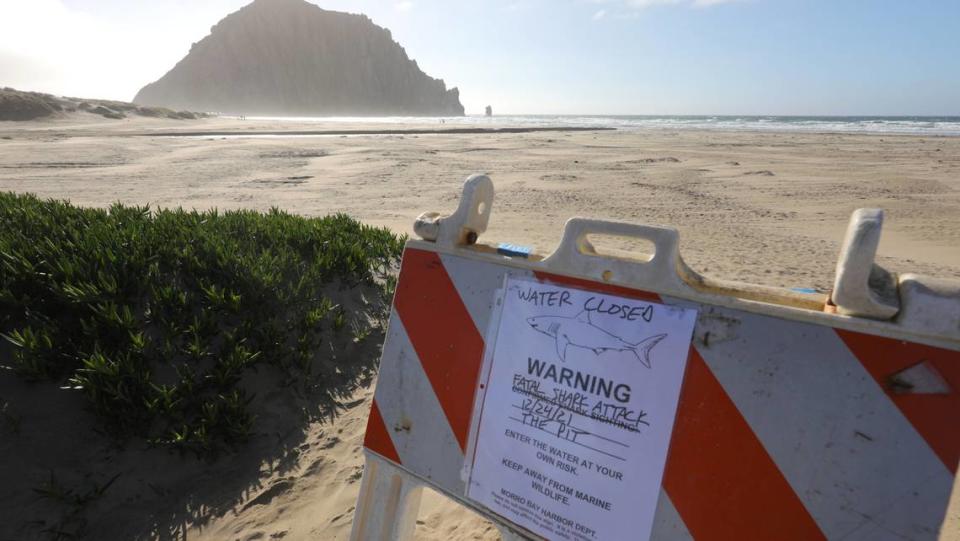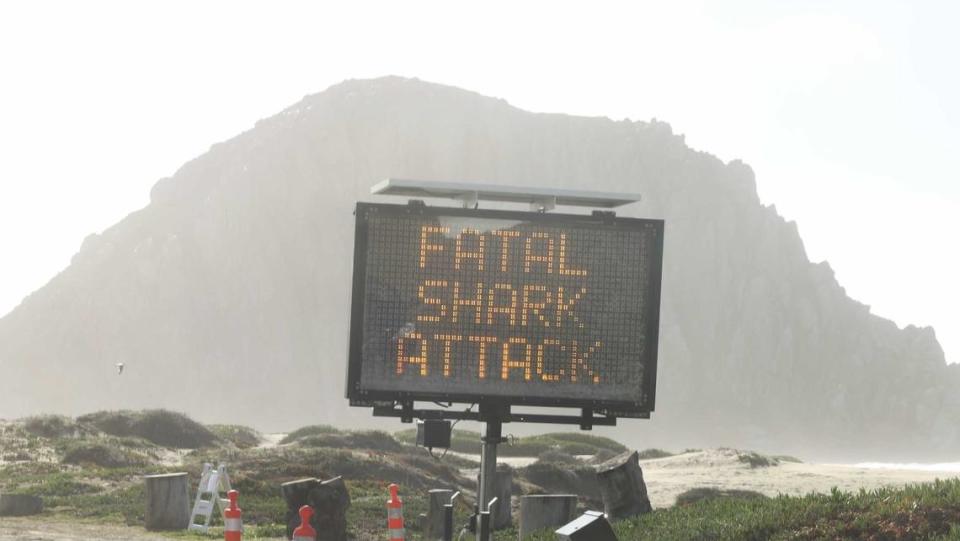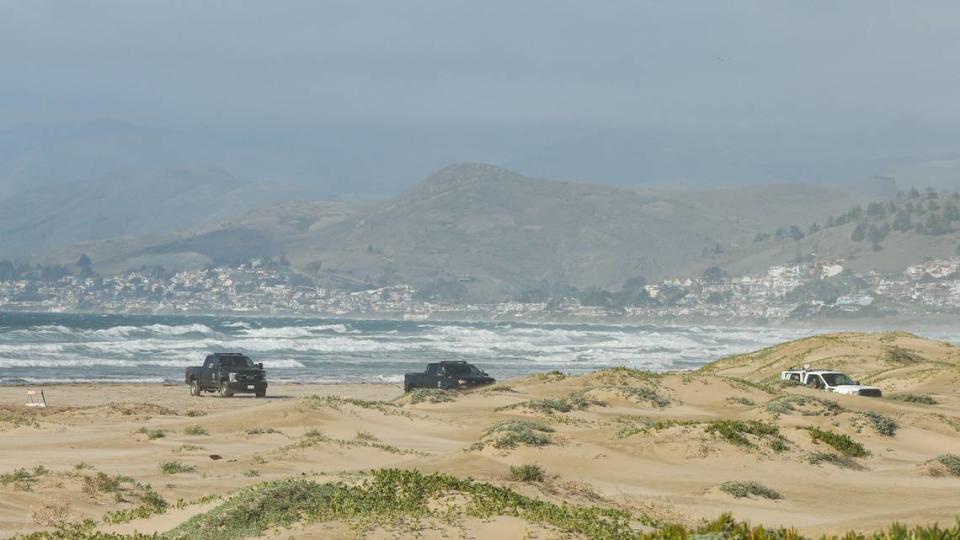‘A new white shark frontier’: Morro Bay attack focuses attention on Central Coast population
The fatal shark attack off the coast of Morro Bay has sent shockwaves through the community as surfers and beachgoers alike try to make sense of the tragedy.
But it also raises new questions about the infamous great white sharks who occupy the ocean off the Central Coast.
Although it’s hard to tell exactly how many white sharks frequent local waters, researchers estimate that the population has steadily increased over the past two decades due largely to state and federal protection measures.
“(The Central Coast) is going to be considered kind of a new white shark frontier. We expect to see a lot more shark activity there,” said Chris Lowe, a professor of marine biology and the director of the Shark Lab at CSU Long Beach. “So what that means is people that use the ocean, they have to be more careful than maybe they have been in the past.”
However, Lowe said shark attacks are still extremely rare incidents.
White sharks have a huge range of habitat in the Pacific Ocean — from the Mexican peninsula of Baja California to around the Farallon Islands off San Francisco’s coast and even thousands of miles west toward Japan. The large predatory fish move constantly in search of food and the right water temperatures.
Data on exactly how many white sharks are in the Pacific Ocean off San Luis Obispo County’s coast is particularly hard to gather as monitoring equipment can easily be ripped loose due to the area’s rough winter currents, Lowe said.
But, through rough population estimates gathered over the past decade, scientists have noticed more and more white sharks in the waters off the Central Coast likely because of the ocean there becoming warmer as the global climate changes.
“These are aspects of climate change that we’re just starting to get some data on,” Lowe said. “And what we should be expecting is that white sharks are going to start moving farther north than we’ve seen in the past.”
The redistribution of seals and sea lions along the Central Coast may also play a role in more white sharks being spotted in the area, Lowe added.

Tagged white sharks show some in Central Coast around Christmas Eve attack
Scientists have worked to tag white sharks over the years to better track their movements.
One such organization, the Marine Conservation Science Institute, has tagged several white sharks, some of which have visited the Central Coast recently.
“Poe Girl” — a 17-foot female great white shark who was named by Keith Poe, one of the institute researchers — was tagged on Nov. 23, 2017.
On Oct. 21, the director of the institute, Michael Domeier, posted a warning on Instagram to beachgoers at El Capitan State Beach near the Santa Barbara Channel about Poe Girl.
“Poe Girl is visiting El Capitan State Beach,” Domeier wrote in the post. “She is not your everyday Southern California juvenile; she’s a massive adult that you should avoid.”
Her tag has given off recent pings in Central Coast waters for the past two weeks or so, according to Domeier.
In a recent post on Instagram, Domeier said Poe Girl was located 24 miles south of Morro Bay around 6 p.m. on Dec. 25, which means she was likely in the area at the time the boogie-boarder was killed.
But he also emphasized people shouldn’t jump to conclusions.
“The probability of it being one of our sharks (who killed the boogie-boarder) is very low, since we’ve tagged such a small percentage of the overall population,” Domeier wrote in another post to his Instagram page.
In a different post, Domeier said that the shark tracking technology his organization uses is not exact. The tracking technology can only monitor the locations of sharks when they surface because the technology relies on a radio frequency that cannot penetrate seawater.
“The positions are not based on GPS, and sometimes they are way off. Instead, the satellite estimates the position based upon the change in the frequency of the tag’s signal as it approaches, and then moves away from the tag. It’s a lot of math based upon the Doppler Effect,” wrote Domeier in an Instagram comment to someone with a question about the technology.

Some say surfers and white sharks coexist
The local surf community emphasizes that sharks and surfers have coexisted in the ocean waters for a long time.
“Sharks are used to seeing surfers up and down the coast,” said Mike Jones, owner of the Azhiaziam International surf shop in Morro Bay. “I think they’re pretty smart. I think sharks have an inkling of what we are and what not to do.”
Most in the local surf community agree that the attack that left one boogie-boarder dead is a tragic accident.
“They’re always here,” said Bill Bookout, owner of the Pismo Beach Surf Shop and Avila Beach Surf Shop. “If you were to fly a drone out there, you’re going to see sharks. A lot of the times you’ll see great whites right amongst the surfers.”
“It’s not that they’re coming at us,” he added. “It’s more accidents than anything else.”
Jones did say that it would be helpful if the people who track the whereabouts of sharks like Poe Girl could communicate with Harbor Patrol about when sharks with a history of human interactions are in the area, so they could post warnings and get the word out to the surf community.
“That’s what the surfers were all talking about this morning,” Jones said. “If they’re tracking him especially when the water is all muddy, why is there no warning?”
Lowe, the scientist from CSU Long Beach, said the recent attack was an extremely rare incident.
“Despite the fact that we have more sharks in our waters than we’ve seen in a very long time, we have more people going in the ocean recreating in our ocean than ever before, we’re still not seeing a big uptick in bites,” he said.
“Our goal is to get that information out to the public so that they can make better decisions,” Lowe continued. “Nonetheless, people should be aware that climate change is redistributing sharks to places that they may not have been before the population increase.”
Beachgoers and surfers can track Poe Girl and other tagged white sharks on the Marine Conservation Science Institute’s phone app, “Expedition White Shark.”


